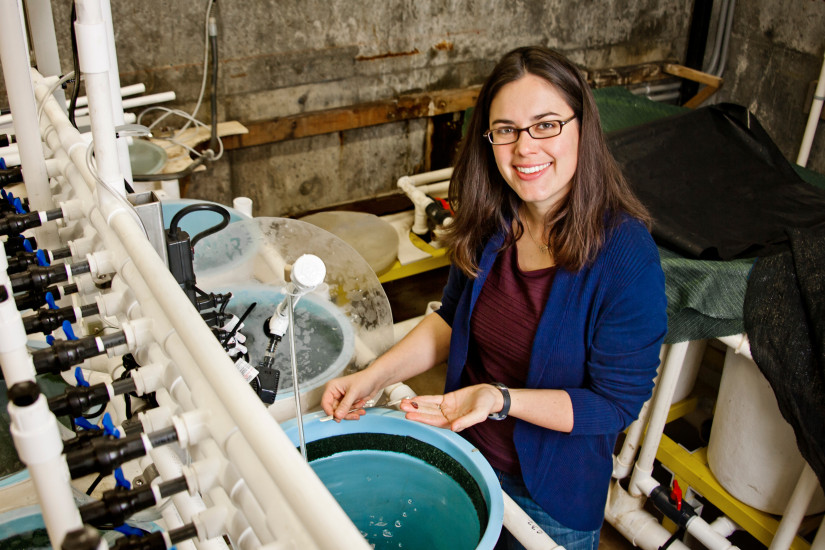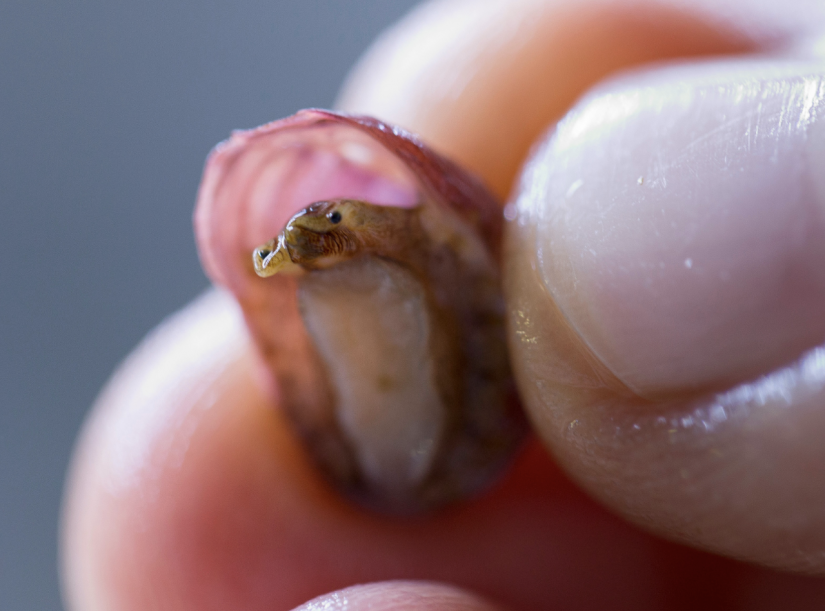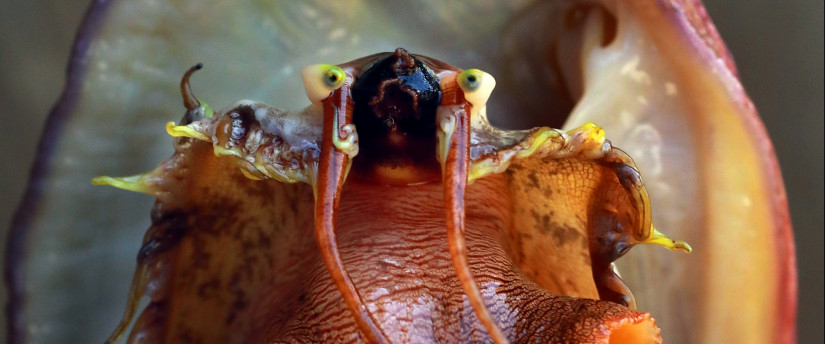The most surprising thing about white abalone isn’t that they’re wildly endangered, or that they’re an ocean-dwelling snail that can live more than 40 years, but that they have a face.
“It’s one of my favorite things to show people in the lab,” says Kristin Aquilino, of the UC Davis Coastal and Marine Sciences Institute and a California Sea Grant extension specialist. “Because to save this species, it’s important that people connect with them.”

With funding from the California Ocean Protection Council, which is administered by California Sea Grant, her research team is working to restore California’s once-thriving population of white abalone (Haliotis sorenseni).
Following a statewide population crash due to overfishing, white abalone were the first marine invertebrate to be listed under the Endangered Species Act in 2001. Their numbers are so low in the wild that these slow-moving snails are simply too far apart to successfully reproduce. Anything more than two or three meters between individuals and their water-borne gametes just can’t reach each other before getting swept away by the current or preyed on by hungry fish.
The only real chance for white abalone recovery depends on a successful captive breeding program that can boost their numbers well enough to establish self-sustaining populations.

But breeding them in captivity has come with a number of challenges. In 2001, the first year of the captive breeding program, the researchers rejoiced after successfully producing 100,000 juveniles. Unfortunately, a bacterial infection and exposure to overly warm waters caused 95% to die from Withering Syndrome, named for the fact that an infected abalone will simply stop eating and eventually digest its own foot muscle.
Aquilino joined the team in 2011 when the captive breeding program moved to the UC Davis Bodega Marine Laboratory, after nearly a decade of unsuccessful breeding attempts. Researchers started treating the abalone with an antibiotic bath and used colder seawater in their tanks, which worked to eliminate mortality from Withering Syndrome. The breeding program has grown more successful each year since.
“Right now I’m averaging about 20,000 one-year old white abalone in a year. It’s really exciting, but it’s also not enough to save the species. We think we want to be out-planting about 100,000 white abalone per year,” says Aquilino.

But each abalone has to grow large enough in captivity before it can be “outplanted,” or released at a designated restoration site where it can be monitored. The smaller the juvenile white abalone are, the more vulnerable to predation, so they are held until they’re about three years old. With the goal of outplanting 100,000 white abalone per year and holding each one for three years, the numbers add up fast. Fortunately, there are about a dozen different locations across California and northern Mexico that are supporting the captive breeding program.
Unfortunately, Withering Syndrome isn’t the only obstacle to recovery. The sea that the abalone are returning to is changing rapidly due to climate change, with both warming waters and ocean acidification a concern. How will the abalone fare when exposed to all three stressors simultaneously?
Preliminary results from lab experiments that simulate these conditions show that under “normal” cold water conditions, without ocean acidification, white abalone can persist even when infected with the Withering Syndrome bacterium. However, when you throw in the added stressor of increased CO2, mortality rates increase, even in cold temperatures.
Certain abalone lineages appear to do better under these conditions, and the researchers are examining whether they can leverage this genetic variation to build a more resilient population.
Tackling the full spectrum of research questions requires a range of expertise. In addition to Aquilino, about a dozen scientists at Bodega Marine Lab contribute to abalone recovery, including Eric Sanford, Jim Moore, Dan Swezey, and Evan Tjeerdema, now at Scripps Institute of Oceanography. They partner with scientists from NOAA, CDFW, and beyond to form the White Abalone Recovery Team.

Although accounting for future conditions is a challenge, it’s the best way to determine the most promising sites for restoration. There are currently two sites where abalone are placed and monitored in southern California, and the locations are kept confidential due to the ongoing risk of poaching. The outplanting team is focusing on sites where white abalone have persisted — albeit at low numbers — because these are likely to provide the most suitable conditions.
Throughout all of the ups and downs, the researchers found a key partner in abalone farmers. Since they’re doing a lot of similar work, they provide a fountain of expertise, and the researchers and farmers can trade discoveries and collaborate to improve methods on spawning and finding ideal conditions for growth. This could be key to helping aquaculture operations for a range of species adapt to growing demand and changing environmental conditions.
Although it will be decades before white abalone is once again a thriving species, Aquilino is hopeful.
“This is a really exciting time in the program, because we are outplanting animals once every few months. And as we grow, we hope that soon we might be able to have some self-sustaining populations in the ocean.”
About California Sea Grant
NOAA’s California Sea Grant College Program funds marine research, education and outreach throughout California. Headquartered at Scripps Institution of Oceanography at the University of California San Diego, California Sea Grant is one of 34 Sea Grant programs in the National Oceanic and Atmospheric Administration (NOAA), U.S. Department of Commerce.